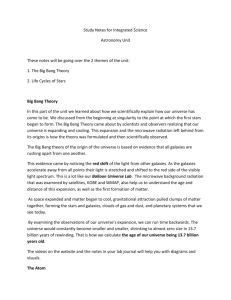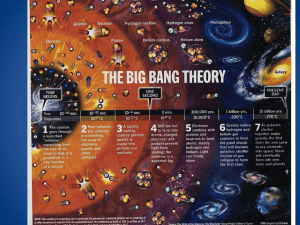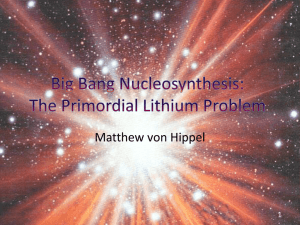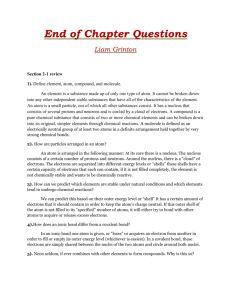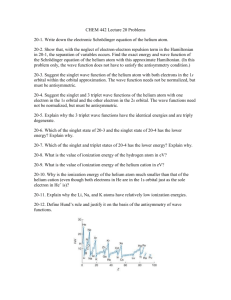1) The dim little star Proxima Centauri, the Sun's nearest neighbor
advertisement
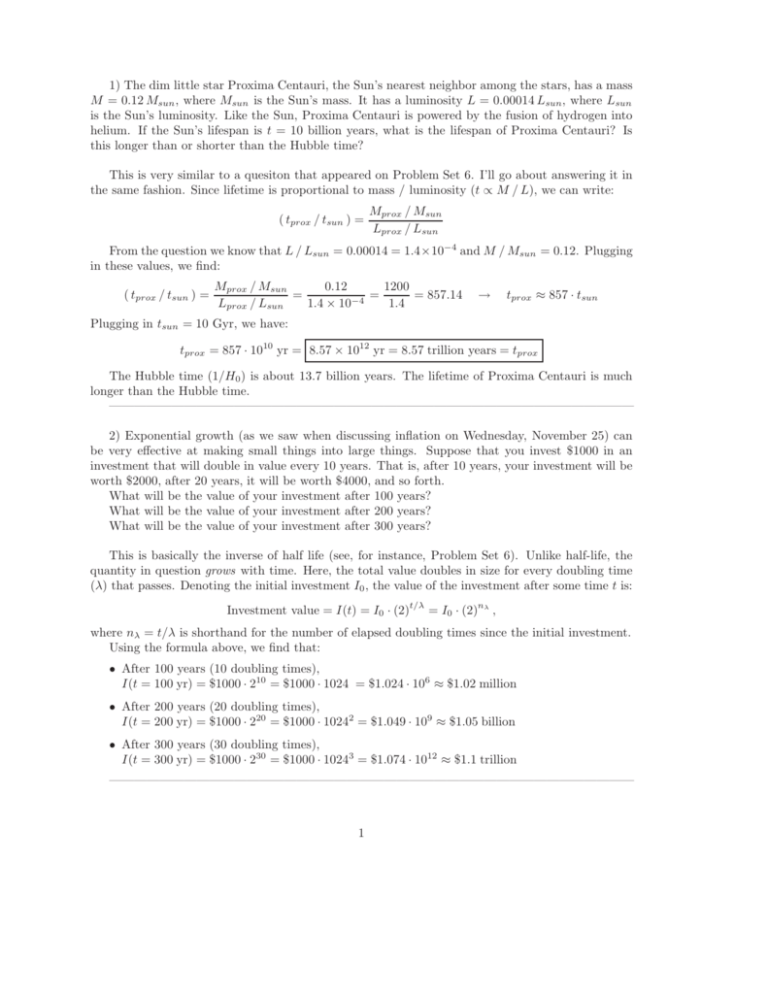
1) The dim little star Proxima Centauri, the Sun’s nearest neighbor among the stars, has a mass M = 0.12 Msun , where Msun is the Sun’s mass. It has a luminosity L = 0.00014 Lsun, where Lsun is the Sun’s luminosity. Like the Sun, Proxima Centauri is powered by the fusion of hydrogen into helium. If the Sun’s lifespan is t = 10 billion years, what is the lifespan of Proxima Centauri? Is this longer than or shorter than the Hubble time? This is very similar to a quesiton that appeared on Problem Set 6. I’ll go about answering it in the same fashion. Since lifetime is proportional to mass / luminosity (t ∝ M / L), we can write: ( tprox / tsun ) = Mprox / Msun Lprox / Lsun From the question we know that L / Lsun = 0.00014 = 1.4×10−4 and M / Msun = 0.12. Plugging in these values, we find: ( tprox / tsun ) = 0.12 1200 Mprox / Msun = = = 857.14 −4 Lprox / Lsun 1.4 × 10 1.4 tprox ≈ 857 · tsun → Plugging in tsun = 10 Gyr, we have: tprox = 857 · 1010 yr = 8.57 × 1012 yr = 8.57 trillion years = tprox The Hubble time (1/H0 ) is about 13.7 billion years. The lifetime of Proxima Centauri is much longer than the Hubble time. —————————————————————————————————————————— 2) Exponential growth (as we saw when discussing inflation on Wednesday, November 25) can be very effective at making small things into large things. Suppose that you invest $1000 in an investment that will double in value every 10 years. That is, after 10 years, your investment will be worth $2000, after 20 years, it will be worth $4000, and so forth. What will be the value of your investment after 100 years? What will be the value of your investment after 200 years? What will be the value of your investment after 300 years? This is basically the inverse of half life (see, for instance, Problem Set 6). Unlike half-life, the quantity in question grows with time. Here, the total value doubles in size for every doubling time (λ) that passes. Denoting the initial investment I0 , the value of the investment after some time t is: t/λ Investment value = I(t) = I0 · (2) nλ = I0 · (2) , where nλ = t/λ is shorthand for the number of elapsed doubling times since the initial investment. Using the formula above, we find that: • After 100 years (10 doubling times), I(t = 100 yr) = $1000 · 210 = $1000 · 1024 = $1.024 · 106 ≈ $1.02 million • After 200 years (20 doubling times), I(t = 200 yr) = $1000 · 220 = $1000 · 10242 = $1.049 · 109 ≈ $1.05 billion • After 300 years (30 doubling times), I(t = 300 yr) = $1000 · 230 = $1000 · 10243 = $1.074 · 1012 ≈ $1.1 trillion —————————————————————————————————————————— 1 3) The temperature of the cosmic background light today is T ≈ 2.7 K. At the time of Big Bang Nucleosynthesis, the temperature of the cosmic background light was T ≈ 5 × 108 K. What was the scale factor a at the time of Big Bang Nucleosynthesis? If the density of ordinary matter today is ρ = 4 × 10−28 kg/m3 , what was the density of ordinary matter at the time of Big Bang Nucleosynthesis? Is this greater than or less than the density of the air around you? First, we need to determine how temperature T is affected by the scale factor a. Recall (notes from Nov 18, page 7) how wavelength changes with scale factor: λ(t) = λ0 · a(t), so then: aBBN = λBBN λnow Since we’re dealing with the temperature of cosmic background light, we can also use the various known formulae for blackbodies (notes from Oct. 7). In particular, recall that: λpeak = 2.9 × 106 nm · K T → λpeak · T = constant Since λ·T is constant, we can write λnow ·Tnow = λBBN ·TBBN . Rearranging this and substituting in the λ ↔ a relation from above, we find: λnow · Tnow = λBBN · TBBN → λBBN Tnow = = aBBN , TBBN λnow Tnow = aBBN TBBN Taking this new formula and plugging in the provided quantities yields: a(t) = T0 T (t) → aBBN = 2.7 K Tnow = 5.4 × 10−9 = aBBN = TBBN 5 × 108 K Next we compute the matter density at the time of Big Band Nucleosynthesis. From the class notes (Nov. 18, page 4), we know: ρ0 ρ(t) = a(t)3 Plugging in the provided values we find: ρBBN = ρnow 4 × 10−28 kg/m3 4 × 10−28 kg/m3 = = 2.54 × 10−3 kg/m3 = ρBBN = 3 −9 3 aBBN (5.4 × 10 ) 1.575 × 10−25 Lastly, we need to compare this to a typical density for air. At sea level, the density of air is approximately ρair ≈ 1.2 kg/m3 (from Wikipedia). The density of ordinary matter at the time of BBN was significantly lower than the density of air in this room! —————————————————————————————————————————— 2 4) Consider an ordinary carbon atom in your body, containing 6 protons and 6 neutrons in its nucleus. Write a brief essay describing the history of this carbon atom. Some questions your essay should answer include: When did the individual protons and neutrons first fuse? When and where did the final carbon nucleus form? How did the carbon atom make its way to Earth? How did it come to inhabit your body? Feel free to indulge your imagination - as long as you don’t violate any known scientific principles! Rather than be too creative, I’ll try to outline the important aspects of the carbon-creation processs and corresponding events/times in the history of our universe. In particular, I’ll cover the answers to the questions about the hypothetical Carbon atom asked above. Not all of this information is required to give a complete answer. The basic points are important. Extra details and background information are provided to help support those points that should be included. Carbon is created in stars by thermonuclear reactions. This occurs by way of the so-called triplealpha process, wherein 3 Helium nuclei (also known as alpha particles) combine to form a single Carbon atom. The 3 Helium atoms that combined to form this Carbon atom were either created early on during Big Bang Nucleosynthesis (BBN) or created later by nuclear fusion in stars. The Earth is not presently acquiring a great deal of Carbon from extra-terrestrial sources. As a result, it’s most likely that the Carbon atom in question is older than our solar system and was present in the blob of material that coalesced into the Sun and planets. The earliest moments of the universe (just after the Big Bang) were a rather tumultuous time. The individual protons and neutrons came into being in the first few seconds after the Big Bang. At this point, protons and neutrons could and did fuse together but it was still too hot for their fusion products (i.e., Deuterium) to survive. Any Deuterium created at this point was ripped apart by high energy photons more or less instantly. About 3 minutes after the Big Bang, the universe had expanded and cooled enough for the aforementioned Deuterium to survive. This marked the beginning of Big Bang Nucleosynthesis (BBN). Protons and neutrons fused together to form Deuterium particles, which occasionally fused further to form Helium nuclei and scarce quantities of Lithium. After several minutes, nucleosynthesis stopped. Roughly 25% of the matter in the universe ended up in Helium nuclei. The remaining 75% remained as Hydrogen (single protons). This is the first possible source of Helium. About 750 million years after the Big Bang, the first generation of stars began to form. Such stars would have formed out of primordial material that already included Helium. This is the earliest that Carbon could be created. Sometime between 750 million years and 8 billion years (when our solar system formed) after the Big Bang, this Carbon atom was created inside a star. In order to end up on Earth, however, it must get out of the star. Both high- and low-mass stars can convert Hydrogen into Helium and then Helium into Carbon (albeit with different efficiency). As a result, it’s perfectly plausible that the Helium predecessors to our Carbon atom were created in this same star (if not by BBN). Additionally, both high- and low-mass stars are able to release this carbon into the environment around them. High-mass stars end in spectacular explosions called supernovae. Massive stars do a great deal of nuclear fusion and create a wide array of heavy elements, including Carbon. When they explode, they release huge amounts of these heavy elements into their environments. Lower-mass stars (like the Sun) spend most of their time fusing Hydrogen into Helium. Towards the end of their lives (the giant phase), there is a small time window within which Helium is fused into Carbon. At the end of this giant phase, the outer layers of the star are expelled into the surrounding interstellar medium. The newly-created carbon atom would have to be in this expelled material in order to escape the star. Once escaped, the Carbon atoms would then mix into their 3 surroundings. Generations of the above procedures have resulted in the heavy element-enriched interstellar material we see today. Our solar system formed out of such an enriched glob of material. Because not much material is exchanged between the planets, this carbon atom would probably have been accreted by the Earth as it formed. A long while later, it found its way into a plant or animal that you ate or a beverage that you drank and absorbed, thus becoming part of your body. 4
